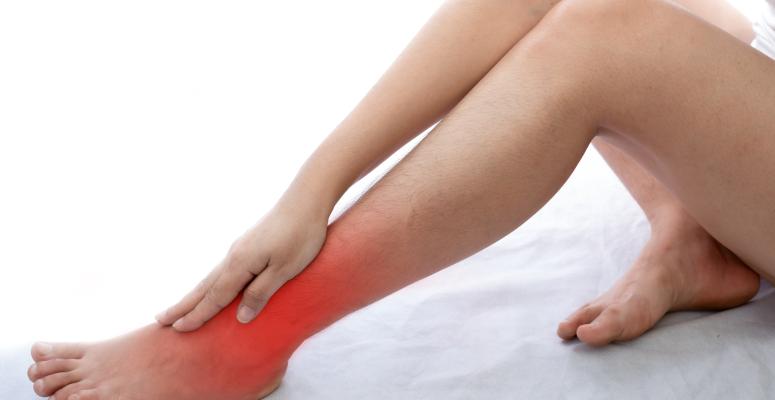
Our ankles have to bear the entire weight of our bodies, so it makes sense that they might hurt every once in a while with the amount of wear and tear we inflict on them. But what does it mean if you’re feeling outside ankle pain?
Ankle pain can stem from a variety of factors, from walking for extended periods of time to awkwardly twisting it when you land from a jump. While many people associate ankle pain with the front or inside of the joint, outside ankle pain can make it difficult to stand or walk. We’re here to teach you about the possible causes of your outside ankle pain.
Read on to learn about the basics of outside ankle pain, the potential causes behind the ache and how you can treat it.
The basics of outside ankle pain
The outside part of your ankle is referred to as the lateral area of the joint, and it’s formed by the fibula bone. At the lower end of the fibula is the lateral malleolus, which is the bony protrusion on the side of your ankle.
Depending on the cause, lateral ankle pain may be coupled with other symptoms that interfere with your mobility, such as ankle instability, tenderness and swelling. Lateral ankle pain is usually categorized as acute or chronic depending on the severity and amount of time that the pain is felt.
Ankle pain is common, with a prevalence rate of up to 15% in the general adult population. But, specifically, lateral ankle pain is normally linked to an injury or medical condition.
5 potential causes for outside ankle pain
There are a few reasons why you could be experiencing lateral ankle pain. It could be sudden onset pain due to an injury, or it could be gradual and develop over time, resulting from a medical condition.
Five possible reasons for your outside ankle pain include:
- Sprain — One of the most common causes of outside ankle pain is a sprained ankle. This acute ankle injury occurs when the ankle is suddenly twisted or rolled to one side, causing the ligaments to be stretched or torn. Ankle sprains are especially common while playing sports. Along with lateral ankle pain, a sprain can also cause swelling and tenderness.
- Peroneal tendinopathy — There are two tendons, called peroneal tendons, that connect your foot to your lower leg to stabilize your ankle and foot. Peroneal tendinopathy, or tendinitis, refers to inflammation of one or both tendons. It can develop from overuse of the tendons and cause lateral ankle pain as well as swelling and redness.
- Peroneal tendon dislocation — Dislocation, or subluxation, is another peroneal tendon issue that can cause lateral ankle pain. If the tendon repeatedly slips or becomes dislocated, it can rub against the lateral malleolus and cause gradual onset ankle pain. It’s caused when your foot is forcefully moved inward and upward from trauma, such as a sprained ankle.
- Sural neuritis — The sural nerve is a sensory nerve that provides sensation to the lateral areas of the lower leg, ankle, heel and foot. Sural neuritis refers to inflammation of the sural nerve, resulting in constant pain that worsens during movement. Sural neuritis can occur when an ankle sprain causes the nerve to stretch or it’s compressed due to ill-fitting footwear.
- Impingement — When the soft tissue in your ankle gets pinched, it’s called ankle impingement. It often occurs at the front or back of the ankle, but the symptoms can manifest in the lateral ankle as well. Impingement can cause instability and pain when your foot is lifted or when you use stairs. It often occurs if an ankle sprain doesn’t heal correctly.
How to treat outside ankle pain
There are several ways to treat outside ankle pain, and the effectiveness of the option depends on the cause and severity of the pain. There are self-care treatment options that can be done from the comfort of your own home, while other options may need the assistance of a physical therapist.
One of the most effective ways to treat lateral ankle pain at home, especially a sprain, is with the RICE method: rest, ice, compression and elevation. Resting your foot and icing the ankle will reduce blood circulation, while compression and elevation decrease the pressure and potential swelling of the joint.
Physical therapy can alleviate your pain as well as restore your ankle’s strength, flexibility and range of motion. A physical therapist can also provide balance training to help increase your stability if you’ve stayed off your feet due to ankle pain.
Alliance PTP is ready to connect you with physical therapy for outside ankle pain
Ready to try in-person physical therapy for your injury or condition? You’ll find plenty of options to choose from among the Alliance Physical Therapy Partners practices nationwide.
Our team can quickly put you in touch with one of our partner clinics near you, and their friendly and knowledgeable local staff can help you find care for your ankle pain.
Don’t have the time to see a physical therapist in person? Not a problem. Alliance PTP and its partners can also see you virtually in nearly every state.
Still have questions about what we and our partners can do for you? We’re ready to answer them and help you find the physical therapy you need.
Get Help at a Location Near You
